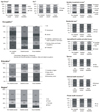Abstract
Purpose
To identify the disparities of socio-demographic factors between visually disabled people and other people with disabilities.
Methods
The fourth Korea National Health and Nutrition Examination Survey (KNHANES III) is a nationwide survey. The present study included 25,125 people who completed the KNHANES III. For analysis, the participants were divided into 3 groups: subjects without disabilities, subjects with disabilities but without visual disabilities, and subjects with visual disabilities. The gender, age, monthly house income, occupation, education, residential area, and health insurance were investigated. Multivariate logistic regression analysis was used to determine the most differentiating factor.
Results
Visually disabled people were proportionally older (40 to 64 years), were male, living in a non-metropolitan area except Seoul/Pusan/Gyunggi compared to other disabled people and also had a higher proportion of the above factors, as well as lower education compared to non-disabled people.
Conclusions
Socio-demographic factors showed disparities in visually disabled people and people with other disabilities. Ophthalmologists should understand these disparities and be involved in establishing policies to reduce the disparities. Ophthalmologists also need to provide holistic and comprehensive medical care using the Blindness is Preventable! Korea Foundation for the Prevention of Blindness, consultation with social work teams in hospitals and other institutions, as well as evaluating the visual impairment.
Figures and Tables
Figure 1
Sociodemographic factors among Non-disabled people, Diabled people, and Visual disabilities. *p-value < 0.01.

References
1. Maberley DA, Hollands H, Chuo J, et al. The prevalence of low vision and blindness in Canada. Eye (Lond). 2006. 20:341–346.
2. Robbins HG. The low vision patient of tomorrow becomes the low vision patient of today. Clin Exp Optom. 2001. 84:101–103.
3. Rahmani B, Tielsch JM, Katz J, et al. The cause-specific prevalence of visual impairment in an urban population. The Baltimore Eye Survey. Ophthalmology. 1996. 103:1721–1726.
4. Newland HS, Woodward AJ, Taumoepeau LA, et al. Epidemiology of blindness and visual impairment in the kingdom of Tonga. Br J Ophthalmol. 1994. 78:344–348.
5. West SK, Munoz B, Rubin GS, et al. Function and visual impairment in a population-based study of older adults. The SEE project. Salisbury Eye Evaluation. Invest Ophthalmol Vis Sci. 1997. 38:72–82.
6. Deaton A, Lubotsky D. Mortality, inequality and race in American cities and states. Soc Sci Med. 2003. 56:1139–1153.
7. Benjamin AE. Consumer-directed services at home: a new model for persons with disabilities. Health Aff (Millwood). 2001. 20:80–95.
8. Kempen JH, Mitchell P, Lee KE, et al. The prevalence of refractive errors among adults in the United States, Western Europe, and Australia. Arch Ophthalmol. 2004. 122:495–505.
9. Muñoz B, West SK, Rodriguez J, et al. Blindness, visual impairment and the problem of uncorrected refractive error in a Mexican-American population: Proyecto VER. Invest Ophthalmol Vis Sci. 2002. 43:608–614.
10. Congdon N, O'Colmain B, Klaver CC, et al. Causes and prevalence of visual impairment among adults in the United States. Arch Ophthalmol. 2004. 122:477–485.
11. Park JH, Lee JY, Kim Y, Moon NJ. Epidemiological analysis and low vision rehabilitation of the visually impaired registered in Seoul. J Korean Ophthalmol Soc. 2009. 50:572–579.




 PDF
PDF ePub
ePub Citation
Citation Print
Print




 XML Download
XML Download